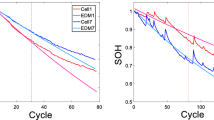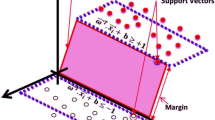Abstract
This paper presents a new fault diagnosis method for switched current (SI) circuits. The kurtoses and entropies of the signals are calculated by extracting the original signals from the output terminals of the circuit. Support vector machine (SVM) is introduced for fault diagnosis using the entropies and kurtoses as inputs. In this technique, a particle swarm optimization is proposed to optimize the SVM to diagnose switched current circuits. The proposed method can identify faulty components in switched current circuit. A low-pass SI filter circuit has been used as test beached to verify the effectiveness of the proposed method. The accuracy of fault recognition achieved is about 97 % although there are some overlapping data when tolerance is considered. A comparison of our work with Long et al. (Analog Integr Circuit Signal Process 66:93–102, 2011), which only used entropy as a preprocessor, reveals that our method performs well in the part of fault diagnostic accuracy.



Similar content being viewed by others
References
Aminian, F., Aminian, M., & Collins, H. W. (2002). Analog fault diagnosis of actual circuits using neural networks. IEEE Transactions on Instrumentation and Measurement, 51(3), 544–550. doi:10.1109/Tim.2002.1017726. Pii S0018-9456(02)15896-5.
Aminian, M., & Aminian, F. (2000). Neural-network based analog-circuit fault diagnosis using wavelet transform as preprocessor. IEEE Transactions on Circuits and Systems Ii-Analog and Digital Signal Processing, 47(2), 151–156. doi:10.1109/82.823545.
He, Y., & Sun, Y. (2001). Neural network-based L1-norm optimisation approach for fault diagnosis of nonlinear circuits with tolerance. IEE Proceedings of the Circuits, Devices and Systems, 148(4), 223–228. doi:10.1049/ip-cds:20010418.
Yuan, L. F., He, Y. G., Huang, J. Y., & Sun, Y. C. (2010). A new neural-network-based fault diagnosis approach for analog circuits by using kurtosis and entropy as a preprocessor. IEEE Transactions on Instrumentation and Measurement, 59(3), 586–595. doi:10.1109/tim.2009.2025068.
Renovell, M., Azais, F., Bodin, J. C., & Bertrand, Y. Testing switched-current memory cells using DC stimuli. In Third International Workshop on Design of mixed-mode integrated circuits and applications, 1999. 1999 (pp. 25–28). doi:10.1109/MMICA.1999.833586.
Saether, G. E., Toumazou, C., Taylor, G., Eckersall, K., & Bell, I. M. Concurrent self test of switched current circuits based on the S2I-technique. In IEEE international symposium on circuits and systems, 1995. ISCAS ‘95. 30 Apr-3 May 1995 (Vols. 2, 842 , pp. 841–844). doi:10.1109/ISCAS.1995.519894.
Chin-Long, W. (1997). Built-in self-test design of current-mode algorithmic analog-to-digital converters. IEEE Transactions on Instrumentation and Measurement, 46(3), 667–671. doi:10.1109/19.585427.
Olbrich, T., & Richardson, A. (1996). Desing and self-test for switched-current building blocks. Design & Test of Computers, IEEE, 13(2), 10–17. doi:10.1109/54.500196.
Renovell, M., Azais, F., Bodin, J. C., & Bertrand, Y. BISTing switched-current circuits. In Proceedings of the Seventh Asian Test Symposium, 1998. ATS ‘98, 2–4 Dec, 1998 (pp. 372–377). doi:10.1109/ATS.1998.741641.
Renovell, M., Azais, F., Bodin, J. C., & Bertrand, Y. Functional and structural testing of switched-current circuits. In Proceedings of the European Test Workshop, 1999, 25–28 May, 1999 (pp. 22–27). doi:10.1109/ETW.1999.803821.
Jierong, G., Yigang, H., Shengxue, T., Hongmin, L., Meirong, L., & Hui, L. (2007). Switched-current circuits test using pseudo-random method. Analog Integrated Circuits and Signal Processing, 52(1–2), 47–55. doi:10.1007/s10470-007-9098-9.
Long, Y., He, Y. G., & Yuan, L. F. (2011). Fault dictionary based switched current circuit fault diagnosis using entropy as a preprocessor. [Article]. Analog Integrated Circuits and Signal Processing, 66(1), 93–102. doi:10.1007/s10470-010-9514-4.
Melgani, F., & Bazi, Y. (2008). Classification of electrocardiogram signals with support vector machines and particle swarm optimization. IEEE Transactions on Information Technology in Biomedicine, 12(5), 667–677. doi:10.1109/TITB.2008.923147.
Koley, C., Purkait, P., & Chakravorti, S. (2007). SVM classifier for impulse fault identification in transformers using fractal features. IEEE Transactions on Dielectrics and Electrical Insulation, 14(6), 1538–1547. doi:10.1109/TDEI.2007.4401238.
Nuryani, N., Ling, S. S. H., & Nguyen, H. T. (2012). Electrocardiographic signals and swarm-based support vector machine for hypoglycemia detection. Annals of Biomedical Engineering, 40(4), 934–945. doi:10.1007/s10439-011-0446-7.
Fu-yuan, H. A particle swarm optimized fuzzy neural network for credit risk evaluation. In Proceedings of the 2nd International Conference on Genetic and Evolutionary Computing, WGEC ‘08. , 25–26 Sept. 2008 (pp. 153–157). doi:10.1109/WGEC.2008.25.
Paulraj, M. P., Hema, C. R., Nagarajan, R., Yaacob, S., & Adorn, A. H. EEG classification using radial basis PSO neural network for brain machine interfaces. In Proceedings of the 5th Student Conference on Research and Development, SCOReD 2007. , 12–11 Dec. 2007 (pp. 1–5). doi:10.1109/SCORED.2007.4451377.
Oja, E., Hyvarinen, A., & Karhunen, J. (2001). Independent component analysis. New York: Wiley.
Nandi, A. K. (1999). Blind estimation using higher-order statistics. New York: Springer.
Cover, T. M., & Thomas, J. A. (2006). Elements of information theory. New York: Wiley-interscience.
Burges, C. J. C. (1998). A tutorial on support vector machines for pattern recognition. Data Mining and Knowledge Discovery, 2(2), 121–167.
del Valle, Y., Venayagamoorthy, G. K., Mohagheghi, S., Hernandez, J. C., & Harley, R. G. (2008). Particle swarm optimization: Basic concepts, variants and applications in power systems. IEEE Transactions on Evolutionary Computation, 12(2), 171–195. doi:10.1109/TEVC.2007.896686.
Kennedy, J., & Eberhart, R. (1995) Particle swarm optimization. In Proceedings of the IEEE International Conference on Neural Networks, (Vol. 4, pp. 1942–1948).
Gaitonde, V. N., & Karnik, S. R. (2012). Minimizing burr size in drilling using artificial neural network (ANN)-particle swarm optimization (PSO) approach. Journal of Intelligent Manufacturing, 23(5), 1783–1793. doi:10.1007/s10845-010-0481-5.
Acknowledgments
The work was supported in part by the National Natural Science Foundation of China for Distinguished Young Scholar under Grant No. 61201108 and No. 61102035, in part by the Hunan Provincial Natural Science Foundation of China under Grant 13JJ6083.
Author information
Authors and Affiliations
Corresponding author
Rights and permissions
About this article
Cite this article
Zhang, Z., Duan, Z., Long, Y. et al. A new swarm-SVM-based fault diagnosis approach for switched current circuit by using kurtosis and entropy as a preprocessor. Analog Integr Circ Sig Process 81, 289–297 (2014). https://doi.org/10.1007/s10470-014-0373-2
Received:
Accepted:
Published:
Issue Date:
DOI: https://doi.org/10.1007/s10470-014-0373-2




